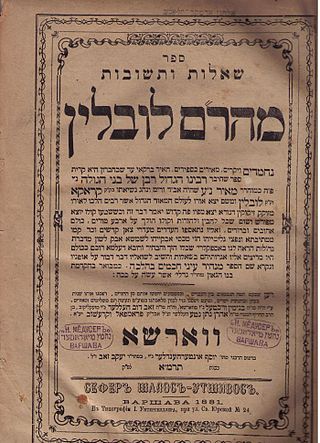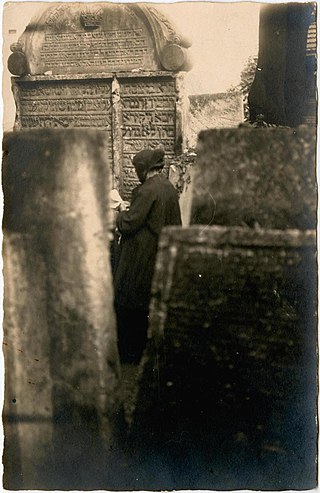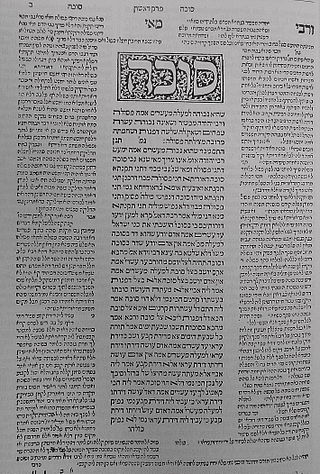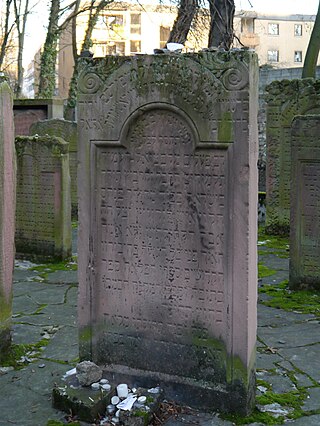This article has multiple issues. Please help improve it or discuss these issues on the talk page . (Learn how and when to remove these template messages)
|
David Meir Frisch (c. 1812-April 25, 1882) [1] was a 19th-century rabbinical authority.
This article has multiple issues. Please help improve it or discuss these issues on the talk page . (Learn how and when to remove these template messages)
|
David Meir Frisch (c. 1812-April 25, 1882) [1] was a 19th-century rabbinical authority.
Rabbi David Meir Frisch (דוד מאיר פריש) (Dawid Majer Frisch, David Mayer Frisch) was born around 1812 [2] in the town of Rohatyn, in western Ukraine, a part of Austria-Hungary at the time. The region was known as Galicia.
Nothing is known of his early years. Neither is the date of his appointment as Rabbi of Berezhany known [3]
An essay [4] by Rabbi Joseph Lewinstein [5] titled "My Kin the "Pene Yehoshua" (Yaakov Yehoshua ben Tzvi Hirsch), [6] traces Rabbi David Meir's lineage to the "Pene Yehoshua". [7]
The maternal fourth generation ancestor of the "Pene Yehoshua", (Joshua Höschel ben Joseph) (1578–1648), himself was the author of a classical commentary on Rashi, the "Meginnei Shelomo" (Amsterdam, 1715), and a collection of responsa, also titled "(Sheeilot uTeshuvot) Pene Yehoshua" (Amsterdam, 1715).
A copy of his rabbinical ordination letter (Hormana) (הורמנא) from Rabbi Shlomo Kluger (1785–1869) is preserved in the opening pages of his only surviving printed work, the Responsa "Yad Meir", (שו"ת יד מאיר) printed in Lemberg in 1881.
This letter, dated in 1840 in Brody, speaks of Rabbi Frisch in laudatory phrases, attests that he engaged him in Halachic arguments on several occasions and although "I vowed not to issue (letters of ordination) to any one, my vow didn't envisage a person of his stature".
Rabbi Frisch addressed queries to many of the rabbinical luminaries of his time, dealing with questions of law, covering all four parts of the Shulchan Aruch, including ritual, marital, monetary and civil matters. To the extent that responsa answering these queries were printed, they appear in the collections of the following luminaries:
Rabbi Shlomo Kluger -approx. 20 responsa
Rabbi Mordechai Zeev Ettinger [8] (1804–1863) – 2 responsa
Rabbi Shlomo Driemer [9] (1800*-1873) – 2 responsa
Rabbi Joseph Saul Nathansohn (1808–1875) – 11 responsa
Rabbi Isaac Aron Ettinga [10] (1827–1891) – 2 responsa
Rabbi Abraham Benjamin Kluger [11] (1841–1916)- 1 responsum
Rabbi Samuel Isaac Schorr [12] (1839–1902) – 1 responsum
Rabbi Abraham Teomim [13] (1814–1868) – 1 responsum.
In addition to his responsa in the Yad Meir, two more responsa have been printed in the works of other authors. Two manuscript responsa were published in recent years in two Talmudic journals. Part of this material was printed in softcover in 2005 on the occasion of the marriage of a great-great-granddaughter [14] in Brooklyn, New York.
While the above appears to comprise virtually all that is known of his output, the author in the foreword of the Yad Meir alludes to "many works" completed by him, going back to the years of his youth, encompassing the entire Babylonian Talmud, another work on the Shulchan Aruch, the Halachot of Niddah, similar in format to the classic "Simlah Chadashah" and the related commentary "Tevuot Shor" of Rabbi Alexander Sender Schor [15] (d. 1737), "a large work"; in addition to a work on Avoth and on the Torah. "I answered many questioners and I give priority to publish [herein] a few of my responsa so that they shall not be forgotten" [16]
At the end of Foreword he alludes that he did not have the means to publish his works and only now, at the prompting of his Rebbetzin, Shaindel, did he print selected responsa "now that our offspring are married off".
The Foreword is dated June 17, 1881. Rabbi David Meir Frisch died ten months later.
In a recent edition [17] of "Divrei Shaul" of Rabbi Joseph Saul Nathansohn (the "Shaul uMeishiv", as he is known in Talmudic literature), the index cites four instances of quotes from Rabbi David Meir Frisch, "Dayan of Berezhany". [18] Chief Rabbi of Lemberg and a towering giant of the rabbinic world of the 19th century, Rabbi Nathansohn was a native of Berezhany and his father the Gaon Rabbi Arye Leib(ush) Nathanson, [19] himself a Talmudic author, [20] continuned to reside in Berezhany and attended the synagogue of Rabbi David Meir Frisch. [21] [ better source needed ]

The "Yad Meir" (translated "Hand of Meir") was published in Lemberg (now Lviv) in 1881, in the year before his passing. It contains 56 responsa (Nos. 1 to 57, with No. 32 missing), most of them addressed to well-known talmudic scholars of his time, including his sons. The numerical value of the Hebrew word "yad" is 14, the same as the value of "David", the author's first name. "Yad" is also the acronym of "Yad David", while Meir is the author's middle name. [22]
Rather than laity, the majority of the questioners in the Yad Meir were rabbis and rabbinical judges (Av Beit Din (AB"D) or Dayan), but not all are identified. The following questioners are identified: [23]
•Rabbi Joshua Falk Zeev (Wolfsohn), [24] AB"D Akna, Moldavia (#1, 2)
•Rabbi David Silber, [25] Dayan, Berezhany (#3, 5, 20, 27)
•Rabbi Hillel Lichtenstein, (1815–1891) AB”D Kolomyia (#4)
•#6 – This responsum, as all the others, is undated and doesn't identify the questioners other than "all the sages of Podhajce" (now Pidhaitsi, Ukraine). The following served there in a senior rabbinic capacity at the time: Rabbi Simon Melier (1810*-1880*), his son Rabbi Nota Jonah Melier (1850*-1910*), or perhaps Rabbi Simon Lilianfeld (1857–1910)(See #13)
•The Righteous Rabbi Uri of Rohatyn [26] (1820–1889)(#7)
•Rabbi Baruch Frisch (1853–1920*) – son of the author. During World War I refugee in Budapest, returned to Berezhany after it ended, date of his passing unknown.(#11, 37)
•Rabbi Gavriel Menkes, [27] AB”D Sambor (Sambir) (d. 1878) (#12)
•Rabbi Shalom Lilianfeld, [28] AB"D Podhajce (1857–1910)(#13, see also #6)
•Rabbi Simon Melier, [29] AB"D Podhajce (1810*-1880*)(#17, see also #6)
•Rabbi Shlomoh Frisch, (1849–1874) son of the author, died young.(#18, 33)
•Rabbi Joseph Pechier, [30] Dayan, Tysmienica (Tysmenytsia) (#22)
•Rabbi David Ber Leiter, [31] AB"D Zawalow (Zavaliv) (1846–1912) (#24, 25)
•Rabbi Moshe Moshil [32] ", AB”D Teatro, Moldavia (#28)
•Rabbi Eliezer Schatzberg, [33] Dayan, Zborow (Zboriv) (#30)
•Rabbi Israel Arye Frisch [34] – brother of author.(#31)
•Rabbi Abraham Benjamin Kluger, son of the Gaon Rabbi Shlomo Kluger (1841–1916) (#34)
•Rabbi Jonah Melier, [35] AB”D Podhajce (1850–1914) (#35)
•Rabbi Arye Leib(ush) Nathansohn [36] of Berezhany, father of the Gaon Joseph Saul Nathansohn (1790–1873)
•Rabbi Pinchas Burstyn, [37] AB”D Sereth (Siret), Bukovina (1829–1906) (#40, 41)
•Rabbi Mottel Frisch – son of author (#42, 44)
•Rabbi Baruch Meir Frisch [38] AB”D Czortków (1820*-1899) (#43)
•Rabbi Tuvyah Klahr, [39] scholar, Zborow (Zboriv) (#45)
•Rabbi Samuel Chayim Gabel, [40] Dayan, Tlumacz (Tlumach) (#48)
•Rabbi Bezalel Ginsburg, [41] Dayan, Tarnopol (Ternopil) (#50)
•Rabbi Joel Moskowicz, Schotz, [42] (1810–1886) son-in-law of the Righteous Rabbi Meir of Premyslany (Peremyshliany) (#51)
•Rabbi Samuel Schapira, [43] Dayan, Dobromil (Dobromyl) (1855–1928) (#54)
•Rabbi Israel [44] AB”D, Novoselic, Bessarabia (#55)
•The Righteous Holy Rabbi Meir of Premyslany (Peremyshliany) [45]
•Rabbi Saul Horowitz [46] 7)
The original Yad Meir is out of print, but appears in the catalogs of the Hebrew University Library, The Smithsonian Institution Hebrew Section, The Yeshiva University Library, Jewish Theological Seminary Library, New York Public Library, The catalogue of Hebrew Books in the British Museum, ed. S. Van Straalen, 1894, the large online database http://hebrewbooks.org/523, and others.
Two young talmudic scholars of rabbinic provenance, Yechiel Mechal Leiter and Yaakov Geller, who studied together, decided to address their Talmudic/Halachic queries to a number of the rabbinical luminaries of their time, and published the responsa received in Lemberg in 1886, under the title “Mazkeret Ahavah” . It includes a short responsum from Rabbi David Meir Frisch, z”tzl..
It is undated. It states that "I received your letter yesterday, but I am bereft of strength and most of the day I am bedridden and the little I do move around in my home, it is hard for me to read…though I usually only respond to practical Halachic questions, but to such lovers and learners of Torah I shall answer two or three of your initial queries, but I cannot read more…"
It appears from the above that Rabbi Frisch had been ill for some time prior to his passing.

Rabbinic literature, in its broadest sense, is the entire spectrum of rabbinic writings throughout Jewish history. However, the term often refers specifically to literature from the Talmudic era, as opposed to medieval and modern rabbinic writing, and thus corresponds with the Hebrew term Sifrut Chazal. This more specific sense of "Rabbinic literature"—referring to the Talmudim, Midrash, and related writings, but hardly ever to later texts—is how the term is generally intended when used in contemporary academic writing. The terms mefareshim and parshanim (commentaries/commentators) almost always refer to later, post-Talmudic writers of rabbinic glosses on Biblical and Talmudic texts.
Geonim were the presidents of the two great Babylonian Talmudic Academies of Sura and Pumbedita, in the Abbasid Caliphate, and were the generally accepted spiritual leaders of the Jewish community worldwide in the early medieval era, in contrast to the Resh Galuta (exilarch) who wielded secular authority over the Jews in Islamic lands.

Meir Lublin or Meir ben Gedalia was a Polish rabbi, Talmudist and Posek. He is well known for his commentary on the Talmud, Meir Einai Chachamim. He is also referred to as Maharam.

Joshua ben Alexander HaCohen Falk was a Polish Halakhist and Talmudist, best known as the author of the Drisha and Prisha commentaries on the Arba'ah Turim as well as Sefer Me'irat Enayim (סמ"ע) on Shulkhan Arukh. His name also occurs as the Hebrew acronyms רפ"כ ("RaFaC"), מהרו"כ ("Ma-HaRWaC"), and מהר"י כ"ץ.

Daniel Bomberg was one of the most important early printers of Hebrew books. A Christian Hebraist who employed rabbis, scholars and apostates in his Venice publishing house, Bomberg printed the first Mikraot Gdolot and the first complete Babylonian and Jerusalem Talmuds, based on the layout pioneered by the Soncino family printers, with the commentaries of Rashi, and of the Tosfot in the margins. The editions set standards that are still in use today, in particular the pagination of the Babylonian Talmud. His publishing house printed about 200 Hebrew books, including Siddurim, responsa, codes of law, works of philosophy and ethics and commentaries. He was the first Hebrew printer in Venice and the first non-Jewish printer of Hebrew books.
The history of responsa in Judaism, spans a period of 1,700 years. Rabbinic responsa constitute a special class of rabbinic literature, differing in form, but not necessarily in content, from Rabbinic commentaries devoted to the exegesis of the Bible, the Mishnah, the Talmud, and halakha. The codes themselves contain the rules for ordinary incidents of life. The responsa literature covers all these topics and more.
Joseph Saul Nathansohn (1808–1875) was a Polish rabbi and posek, and a leading rabbinical authority of his day.

Shemtob Gaguin(e) (5 September 1884 – 30 July 1953) was a British Sephardic rabbi and scion of a famous Moroccan rabbinical dynasty which emigrated to Palestine from Spain at the time of the Inquisition.

Rabbi Pinchas HaLevi Horowitz, also known as the Baal Hafla'ah, was a rabbi and Talmudist.

Rabbi Yechiel Yaakov Weinberg (1884–1966) was an Ashkenazi Orthodox rabbi, posek and rosh yeshiva. He is best known as the author of the work of responsa Seridei Eish.

Rabbi Dov Berish Weidenfeld (1881–1965) was the Chief Rabbi of Tshebin (Trzebinia), Poland, and after World War II spent his final years in Jerusalem. His principal work of Jewish law is titled "Dovev Meisharim".
Ephraim Zalman Margulies was a Galician rabbi born in Brody, brother of Chaim Mordechai Margulies.
Solomon ben Judah Aaron Kluger, known as the Maggid of Brody, was chief dayyan and preacher of Brody, Galicia. He was successively Rabbi at Rava-Ruska (Galicia), Kulikow (Galicia), and Józefów (Lublin), preacher at Brody, and Rabbi at Brezany (Galicia) and, again, at Brody. He died at Brody on June 9, 1869.
Meir ben Isaac Katzenellenbogen was a German rabbi born in Katzenelnbogen.
Reuvein Margolies, was an Israeli author, Talmudic scholar and head of the Rambam library.

Sifrei Kodesh, commonly referred to as sefarim, or in its singular form, sefer, are books of Jewish religious literature and are viewed by religious Jews as sacred. These are generally works of Torah literature, i.e. Tanakh and all works that expound on it, including the Mishnah, Midrash, Talmud, and all works of halakha, Musar, Hasidism, Kabbalah, or machshavah. Historically, sifrei kodesh were generally written in Hebrew with some in Judeo-Aramaic or Arabic, although in recent years, thousands of titles in other languages, most notably English, were published. An alternative spelling for 'sefarim' is seforim.

The gift of the foreleg, cheeks and maw of a kosher-slaughtered animal to a kohen is a positive commandment in the Hebrew Bible. The Shulchan Aruch rules that after the slaughter of animal by a shochet, the shochet is required to separate the cuts of the foreleg, cheek and maw and give them to a kohen freely, without the kohen paying or performing any service.
In Judaism, the presumption of priestly descent is the presumption that a Jewish man is a priest (kohen), based not on genealogical records of descent from Aaron or on Jewish court rulings, but rather by observation of his priestly behavior as recognized by his peers and community. Such an individual is called a kohen muhzak.
The following outline is provided as an overview of and topical guide to Judaism:
Relative hour, sometimes called halachic hour, seasonal hour and variable hour, is a term used in rabbinic Jewish law that assigns 12 hours to each day and 12 hours to each night, all throughout the year. A relative hour has no fixed length in absolute time, but changes with the length of daylight each day - depending on summer, and in winter. Even so, in all seasons a day is always divided into 12 hours, and a night is always divided into 12 hours, which invariably makes for a longer hour or a shorter hour. At Mediterranean latitude, one hour can be about 45 minutes at the winter solstice, and 75 minutes at summer solstice. All of the hours mentioned by the Sages in either the Mishnah or Talmud, or in other rabbinic writings, refer strictly to relative hours.